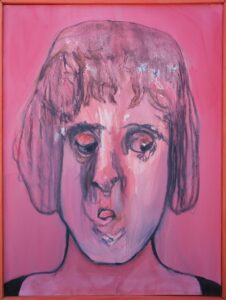Wellfleet’s Bob Henry has been painting and drawing for 70 years, but he’s not the kind of artist who makes the same painting over and over again. There are some constants in his work — like the figure — but he’s consistently open to trying new things. About seven years ago, he had a desire to use an unlikely color for an underpainting. He chose red, and the color stuck. In a subsequent series, he painted figures dancing, seemingly energized by the reds and purples of his palette. In a more recent series, he worked nearly monochromatically in a series of imagined and often humorous portraits. Both series show a deep interest in facial and bodily expressions. Last year, he published For Artists and Art Lovers: A Handbook, a book discussing the ideas that animate his art practice. —Abraham Storer
Q: How did you start the portrait paintings?
These all come from charcoal drawings. For the last, I don’t know, 30 years, I’ve started all my paintings with drawings. Most of the time, I did it with ink drawings, and then I switched to charcoal about six or seven years ago. I just sit down with nothing in my head and start moving my hand. And quite often a face appears.

Q: What kind of reds are you using?
It’s a mixture of cadmium red medium and cadmium red deep with some white.
Q: What does the color red suggest?
Different reds suggest different things. One red can suggest sunlight and warmth and approach you like an atmosphere. If it gets into cadmium red deep, the first word that comes to my mind is blood, but that’s not accurate. It’s like a velvet dress. It’s deep. It sinks into itself.
Q: Have you worked monochromatically before?
Not very much, no. I’ve done so many paintings. Who can remember?
Q: What’s your approach to color?
I go back to studying with Hans Hofmann. He had this phrase: in nature, light makes color, and in painting, color makes light. That’s kind of what I’m after with color but also the decorative part of it and the expressive part of it. It’s a whole bunch of things.
Q: It seems obvious that you’re not interested in local, naturalistic color.
No, I try to stay away from local color, because essentially, I’m an abstract artist who’s working with figures. In this painting, the figure is rendered expressionistically. The white of the nose is clearly the canvas that’s exposed as a result of a brush stroke. The image and the paint are wedded together.
Q: How does white function in a painting?
If there’s white in a painting, it can only be produced by white light. If you don’t put in white, it can look like there’s red light.
Q: Why did you paint the frames red?
It worked with the red paintings. In some of the paintings, the red frame has substance, and the red in the image has atmosphere. So, it’s playing substance against atmosphere.
Q: Why do you always frame your work?
These days, frames are out of fashion. For me, if it’s in a frame, it says it’s a picture. If there’s no frame, it says it’s an object. Even when abstract, my paintings are pictorial.
Q: This portrait is almost like a caricature.
Yes, I’m more and more drawn to the simplicity of something like caricature. I’m into taking away. In my own way, I’ve become a minimalist.
